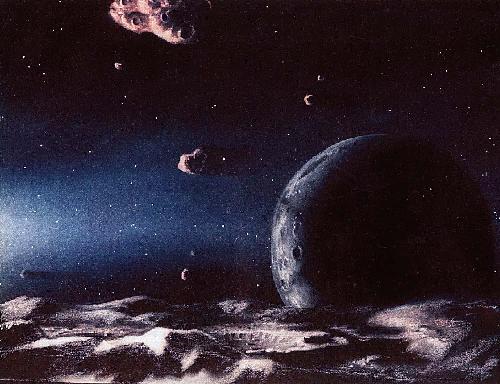| EXTRAORDINARY MULTI-TAILED ASTEROID P/2013 P5 |
|---|
Main-Belt Comets | Comet Home Page | Kuiper Belt Home Page | Ap. J. paper | HST Press Release | Hubble Hangout |
Summary
The strange, multi-tailed appearance of P5, unusual even for "normal" comets from the
Kuiper belt
and
Oort cloud, is also inconsistent with a collisional origin. This is because
we have been able to determine the ages of the tails, finding that they were ejected in sequence from A to F over a 5 month period starting 2013 April. An impact would release an impulsive burst of debris, not a series of burst spread over many months.
Of the remaining
possibilities, one that survives is that P5 been spun-up by
radiation forces to the rotational instability limit. We imagine that the
surface is at the brink of a so-called "shedding instability", like a sandpile tipped to the edge of
collapse. It has not reached the state where the body of the asteroid breaks up. More observations will be obtained to test this possibility.
P/2013 P5 is a Main-Belt Comet
(MBC)
having an orbit within the hot, inner regions
of the asteroid belt. Unlike prototype MBC 133P/Elst-Pizarro and unlike
regular comets,
this object is very unlikely to be driven by the sublimation of
water ice. Its neighbors in the collisionally-produced Flora family are
highly metamorphosed (altered) rocks, that have been heated far above the ice
sublimation temperature. Ice in P5 could not survive.
Caption: Active Asteroid/Main-belt comet P/2013 P5 imaged from the Hubble Space Telescope on 2013 September 10 and 23. Note the multiple tails that swing clockwise between the two dates. These tails are labeled in the right-hand panel, where the image scale and orientation are also given. The portion of the image shown is about 1/2 an arcmin in width. The labeled tails are dust emitted from the 250 meter (or less) radius nucleus.
Click on the images to see a larger version.
Rotational breakup may be an important mechanism for the destruction of small asteroids, rivalling or surpassing impact destruction as the way asteroids die.
Main-Belt Comets | Comet Home Page | Kuiper Belt Home Page | Ap. J. paper | HST Press Release | Hubble Hang out |
Here is a link to our paper in Astrophysical Journal Letters
David Jewitt
 |
 |
|
| Comet | Jewitt | Kuiper |
|---|